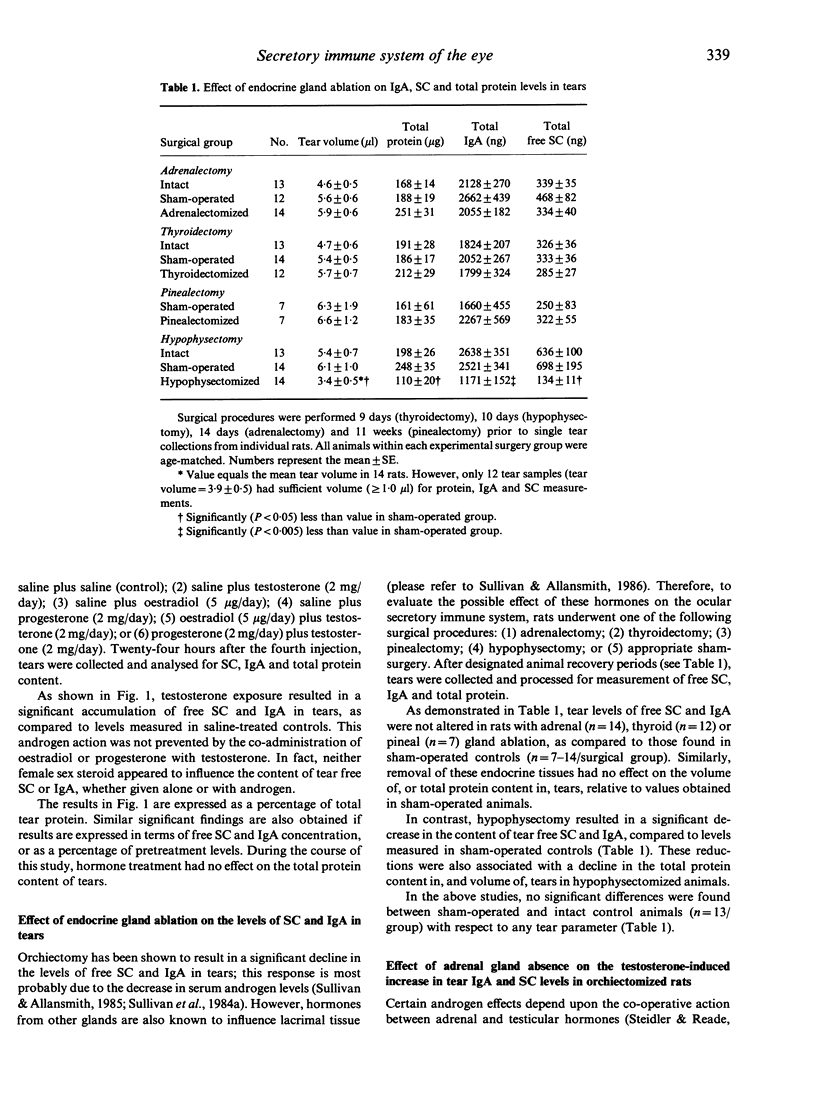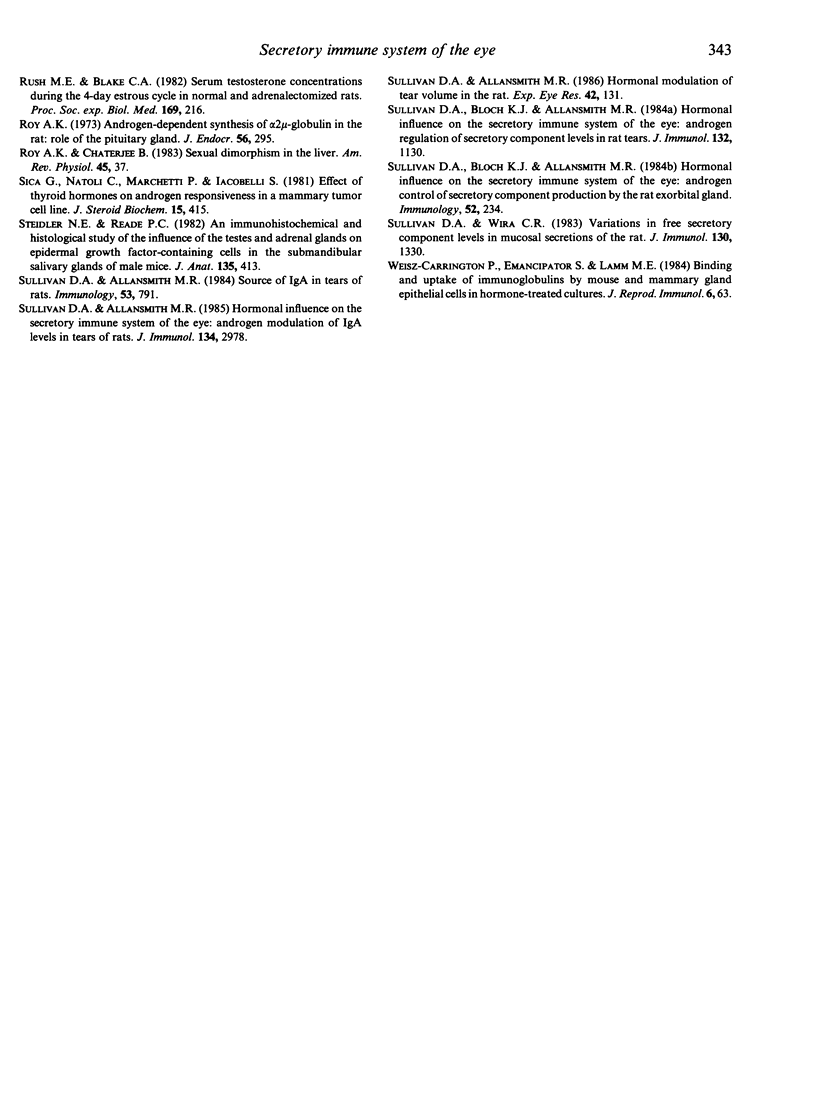Abstract
Previous research from our laboratory has demonstrated that androgens regulate the ocular secretory immune system of the rat. The purpose of the present study was to determine whether other hormones might influence this androgen effect. Experiments involved the daily administration of saline or hormones to adult orchiectomized rats, the collection of tears 24 hr after the fourth hormone injection, and the measurement of free secretory component (SC), IgA and total protein levels in tears. Our first aim was to evaluate whether female sex steroids might antagonize androgen action on tear IgA and SC: orchiectomized rats were treated with combinations of saline, testosterone, oestradiol or progesterone. Testosterone induced a significant increase in the tear SC and IgA concentrations, as compared to those of saline-injected controls. This androgen effect was not inhibited by co-treatment with oestradiol or progesterone, nor duplicated by the administration of these hormones alone. Our second aim was to assess whether the absence of certain hormones might alter tear SC and IgA levels, or influence the ocular response to androgen exposure: rats underwent orchiectomies and specific endocrine organ ablations or appropriate sham-surgery. Absence of the pituitary gland, but not the thyroid, adrenal or pineal glands, resulted in a significant decrease in tear SC, IgA and total protein content. In addition, removal of the thyroid or adrenal glands did not prevent the testosterone-associated increase in tear SC and IgA, although thyroidectomy or adrenalectomy did diminish the magnitude of the androgen response. In contrast, hypophysectomy completely blocked the effect of testosterone on both tear SC and IgA. These results indicate that the hypothalamic-pituitary axis may regulate, or mediate, the action of androgens on ocular immunity in the rat.
Full text
PDF






Selected References
These references are in PubMed. This may not be the complete list of references from this article.
- Aloe L., Levi-Montalcini R. Comparative studies on testosterone and L-thyroxine effects on the synthesis of nerve growth factor in mouse submaxillary salivary glands. Exp Cell Res. 1980 Jan;125(1):15–22. doi: 10.1016/0014-4827(80)90183-4. [DOI] [PubMed] [Google Scholar]
- Barbanel G., Assenmacher I. Effects of thyroid hormones on the ontogeny of oestradiol-binding sites in the rat. Mol Cell Endocrinol. 1982 Nov-Dec;28(3):247–261. doi: 10.1016/0303-7207(82)90124-1. [DOI] [PubMed] [Google Scholar]
- CARRIERE R. THE INFLUENCE OF THE THYROID GLAND ON POLYPLOID CELL FORMATION IN THE EXTERNAL ORBITAL GLAND OF THE RAT. Am J Anat. 1964 Jul;115:1–15. doi: 10.1002/aja.1001150102. [DOI] [PubMed] [Google Scholar]
- Carriere R., Buschke M. The influence of thyroid and testicular hormones on globule leucocytes in the rat duodenal crypt epithelium. Anat Rec. 1978 Nov;192(3):407–421. doi: 10.1002/ar.1091920307. [DOI] [PubMed] [Google Scholar]
- Cavallero C. Relative effectiveness of varous steroids in an androgen assay using the exorbital lacrimal gland of the castrated rat. I. Delta-4-3-ketones and delta-5-3-beta-hydroxysteroids. Acta Endocrinol (Copenh) 1967 May;55(1):119–130. [PubMed] [Google Scholar]
- Chao J., Margolius H. S. Differential effects of testosterone, thyroxine, and cortisol on rat submandibular gland versus renal kallikrein. Endocrinology. 1983 Dec;113(6):2221–2225. doi: 10.1210/endo-113-6-2221. [DOI] [PubMed] [Google Scholar]
- Cornell-Bell A. H., Sullivan D. A., Allansmith M. R. Gender-related differences in the morphology of the lacrimal gland. Invest Ophthalmol Vis Sci. 1985 Aug;26(8):1170–1175. [PubMed] [Google Scholar]
- Crowe J. P., Christensen E., Butler J., Wheeler P., Doniach D., Keenan J., Williams R. Primary biliary cirrhosis: the prevalence of hypothyroidism and its relationship to thyroid autoantibodies and sicca syndrome. Gastroenterology. 1980 Jun;78(6):1437–1441. [PubMed] [Google Scholar]
- Ebling F. J., Ebling E., Randall V., Skinner J. The synergistic action of alpha-melanocyte-stimulating hormone and testosterone of the sebaceous, prostate, preputial, Harderian and lachrymal glands, seminal vesicles and brown adipose tissue in the hypophysectomized-castrated rat. J Endocrinol. 1975 Sep;66(3):407–412. doi: 10.1677/joe.0.0660407. [DOI] [PubMed] [Google Scholar]
- Grossman C. J., Roselle G. A. The interrelationship of the HPG-thymic axis and immune system regulation. J Steroid Biochem. 1983 Jul;19(1B):461–467. doi: 10.1016/0022-4731(83)90204-2. [DOI] [PubMed] [Google Scholar]
- Hartree E. F. Determination of protein: a modification of the Lowry method that gives a linear photometric response. Anal Biochem. 1972 Aug;48(2):422–427. doi: 10.1016/0003-2697(72)90094-2. [DOI] [PubMed] [Google Scholar]
- Jahn R., Padel U., Porsch P. H., Söling H. D. Adrenocorticotropic hormone and alpha-melanocyte-stimulating hormone induce secretion and protein phosphorylation in the rat lacrimal gland by activation of a cAMP-dependent pathway. Eur J Biochem. 1982 Sep 1;126(3):623–629. doi: 10.1111/j.1432-1033.1982.tb06826.x. [DOI] [PubMed] [Google Scholar]
- Johnson H. M., Smith E. M., Torres B. A., Blalock J. E. Regulation of the in vitro antibody response by neuroendocrine hormones. Proc Natl Acad Sci U S A. 1982 Jul;79(13):4171–4174. doi: 10.1073/pnas.79.13.4171. [DOI] [PMC free article] [PubMed] [Google Scholar]
- Lauria A., Porcelli F. Leucine aminopeptidase (LAP) activity and sexual dimorphism in rat exorbital lacrimal gland. Basic Appl Histochem. 1979;23(2):171–177. [PubMed] [Google Scholar]
- MARTINAZZI M. [Effects of hypophysectomy on the extra orbital lacrimal gland of the rat]. Folia Endocrinol Mens Incretologia Incretoterapia. 1962 Feb;15:120–129. [PubMed] [Google Scholar]
- Motwani N. M., Unakar N. J., Roy A. K. Multiple hormone requirement for the synthesis of alpha 2u-globulin by monolayers of rat hepatocytes in long term primary culture. Endocrinology. 1980 Nov;107(5):1606–1613. doi: 10.1210/endo-107-5-1606. [DOI] [PubMed] [Google Scholar]
- Nagy E., Berczi I., Friesen H. G. Regulation of immunity in rats by lactogenic and growth hormones. Acta Endocrinol (Copenh) 1983 Mar;102(3):351–357. doi: 10.1530/acta.0.1020351. [DOI] [PubMed] [Google Scholar]
- Nequin L. G., Alvarez J., Schwartz N. B. Measurement of serum steroid and gonadotropin levels and uterine and ovarian variables throughout 4 day and 5 day estrous cycles in the rat. Biol Reprod. 1979 Apr;20(3):659–670. doi: 10.1095/biolreprod20.3.659. [DOI] [PubMed] [Google Scholar]
- Norstedt G., Mode A. On the primary site of action of estrogens and androgens in the regulation of hepatic prolactin receptors. Endocrinology. 1982 Aug;111(2):645–649. doi: 10.1210/endo-111-2-645. [DOI] [PubMed] [Google Scholar]
- Ota M., Kyakumoto S., Nemoto T. Demonstration and characterization of cytosol androgen receptor in rat exorbital lacrimal gland. Biochem Int. 1985 Feb;10(2):129–135. [PubMed] [Google Scholar]
- Preslock J. P. The pineal gland: basic implications and clinical correlations. Endocr Rev. 1984 Spring;5(2):282–308. doi: 10.1210/edrv-5-2-282. [DOI] [PubMed] [Google Scholar]
- Roy A. K. Androgen-dependent synthesis of aplha-2u globulin in the rat: role of the pituitary gland. J Endocrinol. 1973 Feb;56(2):295–301. doi: 10.1677/joe.0.0560295. [DOI] [PubMed] [Google Scholar]
- Roy A. K., Chatterjee B. Sexual dimorphism in the liver. Annu Rev Physiol. 1983;45:37–50. doi: 10.1146/annurev.ph.45.030183.000345. [DOI] [PubMed] [Google Scholar]
- Rush M. E., Blake C. A. Serum testosterone concentrations during the 4-day estrous cycle in normal and adrenalectomized rats. Proc Soc Exp Biol Med. 1982 Feb;169(2):216–221. doi: 10.3181/00379727-169-41334. [DOI] [PubMed] [Google Scholar]
- Sica G., Natoli C., Marchetti P., Iacobelli S. Effect of thyroid hormones on androgen responsiveness in a mammary tumor cell line. J Steroid Biochem. 1981 Dec;15:415–419. doi: 10.1016/0022-4731(81)90307-1. [DOI] [PubMed] [Google Scholar]
- Steidler N. E., Reade P. C. An immunohistochemical and histological study of the influence of the testes and adrenal glands on epidermal growth factor-containing cells in the submandibular salivary glands of male mice. J Anat. 1982 Sep;135(Pt 2):413–421. [PMC free article] [PubMed] [Google Scholar]
- Sullivan D. A., Allansmith M. R. Hormonal influence on the secretory immune system of the eye: androgen modulation of IgA levels in tears of rats. J Immunol. 1985 May;134(5):2978–2982. [PubMed] [Google Scholar]
- Sullivan D. A., Allansmith M. R. Hormonal modulation of tear volume in the rat. Exp Eye Res. 1986 Feb;42(2):131–139. doi: 10.1016/0014-4835(86)90037-0. [DOI] [PubMed] [Google Scholar]
- Sullivan D. A., Allansmith M. R. Source of IgA in tears of rats. Immunology. 1984 Dec;53(4):791–799. [PMC free article] [PubMed] [Google Scholar]
- Sullivan D. A., Bloch K. J., Allansmith M. R. Hormonal influence on the secretory immune system of the eye: androgen regulation of secretory component levels in rat tears. J Immunol. 1984 Mar;132(3):1130–1135. [PubMed] [Google Scholar]
- Sullivan D. A., Wira C. R. Variations in free secretory component levels in mucosal secretions of the rat. J Immunol. 1983 Mar;130(3):1330–1335. [PubMed] [Google Scholar]
- Weisz-Carrington P., Emancipator S., Lamm M. E. Binding and uptake of immunoglobulins by mouse mammary gland epithelial cells in hormone-treated cultures. J Reprod Immunol. 1984 Feb;6(2):63–75. doi: 10.1016/0165-0378(84)90001-9. [DOI] [PubMed] [Google Scholar]


